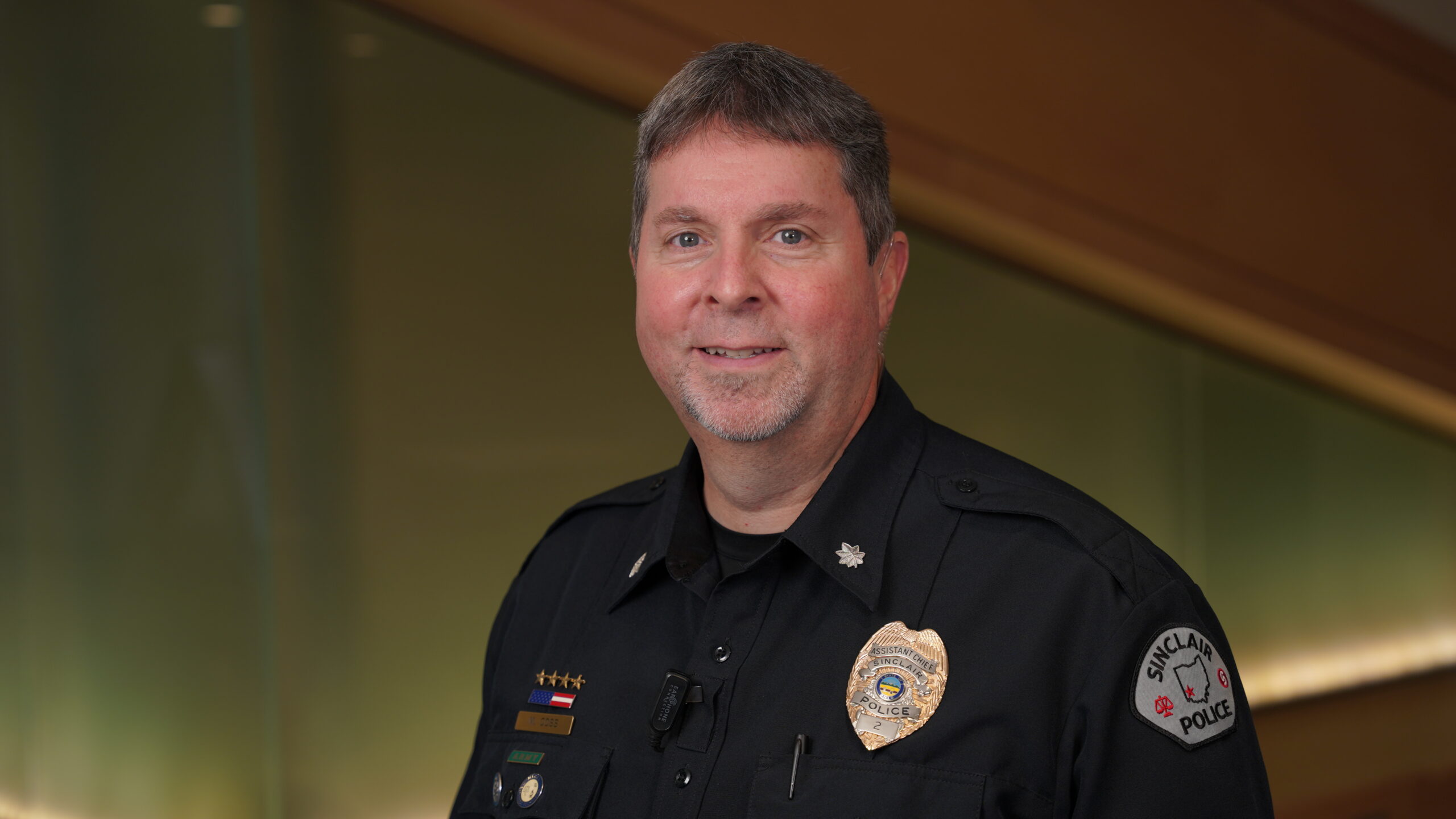Michael Coss, the new Chief of Police at Sinclair Community College, brings nearly 20 years of experience along with a vision focused on trust, community engagement and safety. His leadership prioritizes creating lasting connections within the campus community.
“I started here as a police officer in 2005 and was promoted to Lieutenant in 2010. I became the assistant chief in 2019 and was appointed to the chief position a couple of weeks ago,” Coss said.
Coss discovered his passion for law enforcement as a high school student through a Youth and Government program that allowed him to work alongside his local chief. After serving in the military, he enrolled in Ohio’s police academy and began his career in a small township.
He saw military service as an excellent way for aspiring officers to gain experience, which he believes prepared him for his current role.
“One of the things that has helped me (my career) is when I got married and went into a different career field than law enforcement. The field I was in allowed me to deal with customers; it was a car dealership, and on the repair side, I assisted people in repairing their vehicles,” Coss said.
Because of this position, his communication and problem-solving abilities further developed, enabling him to prepare for the Ohio police academy training. Coss joined the military before enrolling in Ohio’s police academy and starting his career in a small township.
“I love it here (Sinclair). Early on, it became clear to me that this was a place that I could see doing a job in law enforcement in this environment, because it is different than doing it for a city like Dayton or doing it for a county like Montgomery County. It’s different; we have the ability here to develop relationships with people. We can be very proactive here and find out how we can help people. Our jobs are to go around, get to know people, find out what they need and how we can help,” Coss said.
He explained that Sinclair’s police officers’ roles go beyond traffic stops. They focus on connecting with the campus community, understanding people’s needs, offering help, and striving to break the stereotypes often associated with law enforcement.
“When I decided to switch my career and get back into law enforcement, one of the things that I wanted to do is no matter where I went to work and no matter what capacity I was working there, whether it be an officer, supervisor. I wanted to do whatever I could at my level to make that agency the best it could be. Be in a place where people want to come and work and focus on the mission of caring for people, whatever that looks like,” Coss said.
He believes achieving this goal sometimes requires improvements; other times it means maintaining what has already been done. However, he always seeks ways to improve things for the department and serve the community better.
Coss hopes to create a campus where everyone feels seen, heard, and safe. He plans to build relationships in various ways, including having a full-time training coordinator to engage students, faculty and staff in safety education designed to meet individual needs.
The Sinclair police department actively engages with the campus and the broader Dayton community, partnering with organizations such as the Montgomery County ID drive and the Dayton Boys and Girls Club (BGCD). The BGCD supports local youth, providing a safe space that fosters creativity and addresses their changing needs which is now accessible to all young people in the Dayton area.
The Sinclair police department has also intentionally reached out to the large population of international students at Sinclair, aiming to lessen any fears about law enforcement, acknowledging that many individuals from different backgrounds may have had negative experiences with police.
Despite knowing that there will always be students and staff who do not think highly of police officers or law enforcement in general, Coss expressed his desire to put their minds at ease by at least letting them know that not every police officer is the same and that having them here makes the campus safer.
< Black History Month Inspires Reflection and Action for a Better Future >
To ensure inclusivity and sensitivity within his department, Coss is committed to building relationships and getting to know the various clubs and organizations on campus.
He plans to address potential bias or discrimination within his department by providing ongoing training to internal staff and the broader community, helping officers learn from diverse experiences and perspectives. Coss stresses the importance of police engagement within the Dayton community, as it helps build understanding and trust with community members. One officer is also working on a presentation that will discuss these issues. It will be presented to both police officers and the community.
The Sinclair police department addresses emergencies through regular safety committee meetings, ongoing staff training and collaboration with external agencies like the University of Dayton. Officers participate in monthly training to stay prepared for crises, including natural disasters and active shooter situations.
Coss went on to share an experience where he successfully managed a crisis in a critical accident:
He once experienced a tornado warning during which there was confusion about the severity of the threat. A tornado was reported nearby, leading to widespread panic among students and staff who were ready to seek shelter; however, Coss’s quick action in this situation showed his ability to manage crisis effectively, ensuring the safety of the campus.
“We are a storm-ready college, which has certain training and certifications you have to meet, and we have maintained that. So, we were already aware of that tornado,” Coss said.
The Sinclair police department also has an emergency text alert system that informs people about anything dangerous around the campus before it is announced on the public address system.
Coss plans to collaborate with other departments on campus, such as Student Services and Counseling, by being actively involved with the care team and having an active relationship with both departments. The care team was once known as the Behavioral Intervention Team (BIT) until its name was changed last year. Sinclair police have had this relationship for as long as Coss has worked here.
The care team meets weekly to discuss concerns of students, faculty, or staff and allows for issues related to behavioral problems, housing struggles, or mental health. This ensures appropriate resources, including counseling services or police involvement, are engaged as needed.
Coss highlighted the importance of creating an environment where people feel safe. He believes that the perception of safety is as vital as actual crime statistics, and initiatives that help people feel secure will significantly measure success.
“We continue to enhance our camera capabilities here, not only by adding cameras in specific locations but also by using the different technologies you can use on cameras, especially when searching functions. Because rather than go back and try to look for something that happened manually, there is software that you can add to that to help you look for that much quicker.”
He said they are looking for other technologies for panic and duress alarms throughout campus because such devices are portable and stay with people rather than just in a fixed location.
While there are no cameras in every staircase or building due to budget considerations, there is a master plan to implement cameras in phases. The focus has been on high-traffic areas, such as exterior doors and emergency blue light stations, where cameras are installed to monitor activity and respond to emergencies.
These emergency blue lights have cameras that provide officers with immediate visual access to any incidents that may occur when the alarm is activated. Aiming to enhance the department’s ability to respond effectively to emergencies.
To measure the success of his initiatives to improve campus safety, Coss highlighted the importance of gathering feedback from students, faculty and staff. This firsthand information will help assess how the community feels about safety measures and their effectiveness.
Knowing that crime statistics alone do not provide a complete picture, Coss intends to monitor these numbers as one indicator of safety improvements. He recognizes that even with advanced safety measures, crime may still occur, but reducing incidents would be a positive sign.
Coss sees the biggest challenge facing campus security today as the ongoing threat of an active shooter or similar incidents. He pointed out that while such events may not have occurred on their campus, the frequency of these incidents elsewhere creates concerns.
Changes in campus infrastructure, such as increased glass in buildings, also present new challenges for securing spaces and ensuring safety during emergencies. To address this challenge, Coss plans to apply emergency preparedness, where the department is committed to being ready for emergencies by maintaining a safety committee.
Through a thoughtful approach to each situation, Coss encouraged officers to balance enforcing rules while maintaining a positive relationship with students. When confronted with a problem, officers are encouraged to assess the nature of the incident while considering whether it involves a legal violation, breach of the student code of conduct or both.
Coss advises aspiring law enforcement professionals to build relationships with those in the field and explore various roles from street officers to forensic specialists. He emphasizes learning from experienced individuals to gain a realistic understanding of the profession beyond the often-misleading portrayals in media and television, which do not often show the accurate reality of law enforcement.
Under Coss’s leadership, Sinclair’s campus will be safer and more welcoming to everyone. Being trusted with such a position says a lot about who he is as a person and at work. With his experiences as a police officer and vision, it is no surprise that the police department chose him as the new chief police officer.
Esperance Amuri, Online Editor


